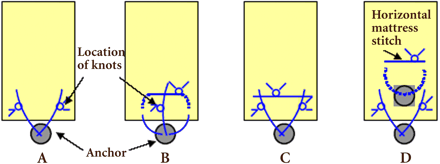Biomechanical Evaluation of Arthroscopic Rotator Cuff Repairs: Double-Row Compared with Single-Row Fixation
Authors: C. Benjamin Ma, Lyn Comerford, Joseph Wilson, and Christian M. Puttlitz
References: J Bone Joint Surg Am. 2006;88:403-410
Abstract
Background: Recent studies have shown that arthroscopic rotator cuff repairs can have higher rates of failure than do open repairs. Current methods of rotator cuff repair have been limited to single-row fixation of simple and horizontal stitches, which is very different from open repairs. The objective of this study was to compare the initial cyclic loading and load-to-failure properties of double-row fixation with those of three commonly used single-row techniques.
Methods: Ten paired human supraspinatus tendons were split in half, yielding four tendons per cadaver. The bone mineral content at the greater tuberosity was assessed. Four stitch configurations (two-simple, massive cuff, arthroscopic Mason-Allen, and double-row fixation) were randomized and tested on each set of tendons. Specimens were cyclically loaded between 5 and 100 N at 0.25 Hz for fifty cycles and then loaded to failure under displacement control at 1 mm/sec. Conditioning elongation, peak-to-peak elongation, ultimate tensile load, and stiffness were measured with use of a three-dimensional tracking system and compared, and the failure type (suture or anchor pull-out) was recorded.
Results: No significant differences were found among the stitches with respect to conditioning elongation. The mean peak-to-peak elongation (and standard error of the mean) was significantly lower for the massive cuff (1.1 ± 0.1 mm) and double-row stitches (1.1 ± 0.1 mm) than for the arthroscopic Mason-Allen stitch (1.5 ± 0.2 mm) (p < 0.05). The ultimate tensile load was significantly higher for double-row fixation (287 ± 24 N) than for all of the single-row fixations (p < 0.05). Additionally, the massive cuff stitch (250 ± 21 N) was found to have a significantly higher ultimate tensile load than the two-simple (191 ± 18 N) and arthroscopic Mason-Allen (212 ± 21 N) stitches (p < 0.05). No significant differences in stiffness were found among the stitches. Failure mechanisms were similar for all stitches. Rotator cuff repairs in the anterior half of the greater tuberosity had a significantly lower peak-to-peak elongation and higher ultimate tensile strength than did repairs on the posterior half.
Conclusions: In this in vitro cadaver study, double-row fixation had a significantly higher ultimate tensile load than the three types of single-row fixation stitches. Of the single-row fixations, the massive cuff stitch had cyclic and load-to-failure characteristics similar to the double-row fixation. Anterior repairs of the supraspinatus tendon had significantly stronger biomechanical behavior than posterior repairs.
Clinical Relevance: The results of this study support the concept that double-row fixation can improve the initial fixation strength of arthroscopic rotator cuff repairs.

Schematic diagrams of the four stitch configurations in this study. (A) The two-simple repair: two simple stitches through one anchor. (B) The arthroscopic Mason-Allen repair: a horizontal mattress and simple stitch through the same suture anchor. (C) The massive cuff repair: a horizontal loop tied separately to act as a checkrein loop and two simple stitches through one anchor passed medial to the horizontal loop. (D) Double-row fixation: two simple stitches through a laterally based suture anchor and one horizontal mattress stitch through a medially based suture anchor.
Data on the Biomechanical Behavior of the Four Stitches and the Number of Anchor Pull-outs in the Ten Specimens:
|
| |||||||
| Stitch | |||||||
| Two Simple |
Arthroscopic Mason-Allen |
Massive Cuff |
Double Row | ||||
| Cyclic loading test* | |||||||
| Conditioning elongation (mm) | 2.0 ± 0.3 | 2.3 ± 0.3 | 1.5 ± 0.3 | 1.3 ± 0.1 | |||
| Peak-to-peak elongation (mm) | 1.4 ± 0.2 | 1.5 ± 0.2  |
1.1 ± 0.1 | 1.1 ± 0.1 | |||
| Load-to-failure test* | |||||||
| Ultimate tensile load (N) | 191 ± 18  |
212 ± 21  |
250 ± 21 |
287 ± 24 | |||
| Stiffness (N/mm) | 93 ± 6 | 101 ± 17 | 114 ± 13 | 112 ± 14 | |||
| No. of anchor pull-outs |
0 |
1 |
3 |
1 | |||
 Compared with the double-row fixation, the difference was significant (p < 0.05)
Compared with the double-row fixation, the difference was significant (p < 0.05)
 Compared with the massive cuff, the difference was significant (p < 0.05)
Compared with the massive cuff, the difference was significant (p < 0.05)


